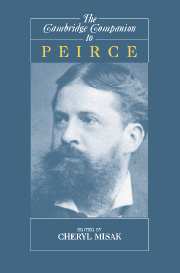Book contents
- Frontmatter
- 1 Charles Sanders Peirce (1839-1914)
- 2 Peirce's Place in Pragmatist Tradition
- 3 Peirce and Medieval Thought
- 4 Reflections on Inquiry and Truth Arising from Peirce's Method for the Fixation of Belief
- 5 Truth, Reality, and Convergence
- 6 C. S. Peirce on Vital Matters
- 7 Peirce's Common Sense Marriage of Religion and Science
- 8 Peirce's Pragmatic account of Perception
- 9 The Development of Peirce's Theory of Signs
- 10 Peirce's Semeiotic Model of the Mind
- 11 Beware of Syllogism
- 12 Peirce's deductive Logic
- Note on References
- Bibliography
- Index
1 - Charles Sanders Peirce (1839-1914)
Published online by Cambridge University Press: 28 May 2006
- Frontmatter
- 1 Charles Sanders Peirce (1839-1914)
- 2 Peirce's Place in Pragmatist Tradition
- 3 Peirce and Medieval Thought
- 4 Reflections on Inquiry and Truth Arising from Peirce's Method for the Fixation of Belief
- 5 Truth, Reality, and Convergence
- 6 C. S. Peirce on Vital Matters
- 7 Peirce's Common Sense Marriage of Religion and Science
- 8 Peirce's Pragmatic account of Perception
- 9 The Development of Peirce's Theory of Signs
- 10 Peirce's Semeiotic Model of the Mind
- 11 Beware of Syllogism
- 12 Peirce's deductive Logic
- Note on References
- Bibliography
- Index
Summary
INTRODUCTION
Charles Sanders Peirce was the founder of pragmatism - the view that our theories must be linked to experience or practice. His work is staggering in its breadth and much of it lies in a huge bulk of manuscripts and scraps. His few published papers include those of the 1870s series in Popular Science Monthly called “Illustrations of the Logic of Science,” most notably “How to Make Our Ideas Clear” and “The Fixation of Belief.” His Lowell Lectures in 1898 and 1903 and his Harvard Pragmatism Lectures in 1903 also contain essential material. But much of what is important is only now being published in the definitive chronological edition: The Writings of Charles Sanders Peirce.
Peirce was a difficult man and this was no doubt partly responsible for his being frozen out of what he most desired: a permanent academic position. He worked instead for the U.S. Coast Survey – his scientific and mathematical endeavors there had a significant influence on his logic, on his work in statistical inference, and on his epistemology and metaphysics. He is perhaps best known today for his theory of truth and his semeiotics, as well as for his influence on William James and John Dewey. But because of the scattered nature of his work and because he was always out of the academic mainstream, many of his contributions are just now coming to light.
- Type
- Chapter
- Information
- The Cambridge Companion to Peirce , pp. 1 - 26Publisher: Cambridge University PressPrint publication year: 2004
- 28
- Cited by

